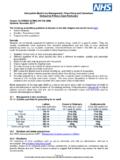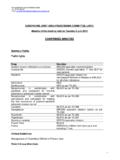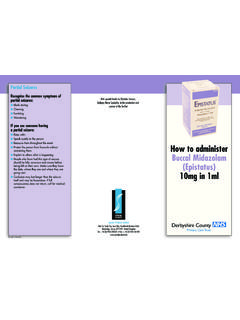Transcription of Menopause Guidelines - Derbyshire Medicines Management
1 Produced: January 2016 Updated: March 2020 Next review date: February 2023 Page 1 of 8 Menopause Management GUIDELINE (based on nice NG23/ British Menopause Society Guidance) Whilst JAPC recommend a list of cost-effective treatments in this guidance, alternative available products may be prescribed during ongoing national supply shortage of Hormone Replacement Therapy (HRT). The British Menopause Society (BMS) has recently issued an update on HRT supply to provide guidance to clinicians on the current availability of HRT products. Other resources which can be found on the BMS website include HRT preparations and equivalent. The Department of Health and Social Care (DHSC) have issued three new Serious Shortage Protocols (SSPs) - Oestrogel Pump Pack , Ovestin 1mg cream, and Premique Low Dose MR tablets, with advice to issue no more than 3months supply of these Medicines . General Principles Diagnose Menopause / perimenopause without laboratory tests in otherwise healthy women aged over 45 years with menopausal symptoms.
2 There should be a holistic and individualised approach in assessing menopausal women. See appendix 1 for preferred formulary choices. Alternatives may be preferred on an individual basis. All women should be able to access advice on how they can optimise their Menopause transition and the years beyond. Give information in different formats on the cause of the Menopause , common symptoms, long term health implications, health-improving lifestyle changes and interventions, benefits and risks of hormonal, non-hormonal and non-pharmaceutical treatments. The decision whether to use Hormone Replacement Therapy (HRT) should be made by each woman having been given sufficient accurate information to make a fully informed choice. HRT prescribed before the age of 60 has a favourable benefit / risk profile. Offer HRT first-line for menopausal related vasomotor symptoms after discussing short term and long term benefits and risks.
3 Review HRT treatment 3 months after commencing, and annually thereafter once settled on treatment. Selective serotonin uptake inhibitors (SSRI), selective noradrenaline uptake inhibitors (SNRI) antidepressants or clonidine should not be routinely offered first line treatment for vasomotor symptoms. For Menopause related low mood, consider HRT and or cognitive behavioural therapy (CBT) (SSRIs and SNRIs have not been shown to help unless depression is diagnosed) Topical testosterone gel (Testogel) is Green after specialist recommendation for use in patients whose HRT does not improve low sexual desire on its own (off-label indication). Specialist will provide dose & instruction for its use*. Offer and continue vaginal oestrogen to relieve symptoms of urogenital atrophy (usually long-term as symptoms recur on stopping vaginal oestrogen). Do not routinely measure endometrial thickness to monitor treatment.
4 Women should be advised to report any unscheduled bleeding to their GP. (Higher dose may be indicated temporarily- contact a local Menopause expert for advice) Arbitrary limits should not be placed on the duration of usage of HRT; if symptoms persist, the benefits of hormone therapy usually outweigh the risks. Offer women who are stopping HRT a choice of gradually reducing (may limit recurrence of symptoms short term) or immediately stopping treatment, which makes no difference to symptoms in longer term. Women who are likely to start Menopause because of medical or surgical treatment need support and information about it before treatment starts. Derbyshire JOINT AREA PRESCRIBING COMMITTEE (JAPC) Produced: January 2016 Updated: March 2020 Next review date: February 2023 Page 2 of 8 Premature Ovarian insufficiency (POI) Diagnose POI in women aged under 40 years based on: menopausal symptoms, including no or infrequent periods (taking into account whether the woman has a uterus) and elevated FSH levels on two blood samples taken 4 6 weeks apart.
5 Women with POI should be encouraged to use HRT at least until the average age of the Menopause . HRT and the combined contraceptive pill (COCP) would both be suitable options to consider, however, HRT may result in a more favourable improvement in bone density and cardiovascular markers compared with the COCP. * for further detail see Global Consensus Position Statement on The use of Testosterone Therapy for Women. J Clin Endocrinol Metab, October 2019, 104(10):4660 4666. Background The average age for the natural Menopause in the UK is 51: premature Menopause affects 1 in 100 women under the age of 40. About 80% women experience some symptoms (est million women nationally). Symptoms often last for about 4 years but in about 10% of women can last for 12 years or more. Menopause symptoms are often misunderstood, ridiculed and underestimated. However they may severely affect a woman s health and quality of life.
6 Hot flushes and sweats can sometimes be so bad they constantly interrupt sleep and can leave sufferers drenched in sweat and exhausted. Menopause also can result in low mood, osteoporosis and urogenital changes that can cause vaginal dryness, urinary tract infections, and adversely affect a woman s sex life. It is hoped that the guideline will not only support healthcare professionals but also provide women with the necessary information to empower them to go and talk to their healthcare professionals to help them make informed decisions about their choice of treatment. Definitions Perimenopause The time in which a woman has irregular cycles of ovulation and menstruation leading up to Menopause and continuing until 12 months after her final period. The perimenopause is also known as the menopausal transition or climacteric. Postmenopause The time after Menopause has occurred, starting when a woman has not had a period for 12 consecutive months.
7 Premature ovarian insufficiency Menopause occurring before the age of 40 years (also known as premature ovarian failure or premature Menopause ). It can occur naturally or as a result of medical or surgical treatment. Early Menopause Menopause occurring between ages 40-44. Urogenital atrophy Thinning and shrinking of the tissues of the vulva, vagina, urethra and bladder caused by oestrogen deficiency. This results in multiple symptoms such as vaginal dryness, vaginal irritation, a frequent need to urinate and urinary tract infections. Vasomotor symptoms Menopausal symptoms such as hot flushes and night sweats caused by constriction and dilatation of blood vessels in the skin that can lead to a sudden increase in blood flow to allow heat loss. These symptoms can have a major impact on activities of daily living. Benefits of HRT Short term Reduced vasomotor symptoms ( hot flushes, night sweats) Improved psychological symptoms ( low mood, anxiety) and quality of life Improved muscle and joint pains Can improve sexual problems including interest, arousal and pain.
8 Long term Reduced genitourinary symptoms (vaginal dryness, pain on intercourse, urinary urgency).(BMS consensus statement Urogenital atrophy) Stops bone loss, reduces fracture risk, maintains muscle mass and strength. HRT is not associated with an increased risk of developing type 2 diabetes. Reduced risk of bowel cancer with combined HRT (BMS HRT consensus statement 2016). HRT initiated before the age of 60 or within 10 years of the Menopause is likely to be associated with a reduction in coronary heart disease and cardiovascular mortality**. Evidence from the Cochrane data-analysis as well as that from the long-term follow up data of the WHI showed no increase in cardiovascular events, cardiovascular mortality or all-cause mortality in women who initiated HRT more than 10 years after the Menopause . Produced: January 2016 Updated: March 2020 Next review date: February 2023 Page 3 of 8 ** If HRT is to be used in women over 60 years of age, lower doses should be started, preferably with a transdermal route of estradiol administration.
9 Risks associated with HRT in perspective (see also appendix 2) HRT does not increase cardiovascular (CVS) risk when started under age 60 HRT is not contraindicated in women with optimally managed CVS risk factors ( hypertension, diabetes). Consider transdermal HRT in women with a higher background VTE risk including those with a BMI over 30 kg/m2 as oral HRT is associated with a higher risk of venous thromboembolism. MHRA Aug 2019- The risk of breast cancer is increased during use of HRT (except vaginal estrogens), and some risk persists for more than 10 years after stopping HRT. Risk of breast cancer is higher for combined estrogen-progestogen HRT (required in women with a uterus) than estrogen-only HRT. However, there is little or no increase in risk of breast cancer with current or previous use of HRT for less than 1 year. See Patient information leaflet. The recent findings are in keeping with existing evidence; however, a woman has greater risk of developing breast cancer if she is overweight or obese compared to taking HRT.
10 See RCOG & BMS joint statement link. Choice of HRT The choice of HRT for an individual depends on an overall balance of indication, risk-benefit profile, side effects and convenience. Prescribe the lowest effective dose of HRT for the shortest time necessary but arbitrary limits should not be placed on the duration of usage of HRT Start at a low dose especially in older women (may be less tolerant of oestrogen) and increase if symptoms persist after a few months. Tailor the dose to the symptoms, as the ingested or applied dose may not be well absorbed. Low dose estradiol , conjugated oestrogens 300mcg, estradiol patch 25 Standard dose estradiol 2mg, conjugated oestrogens 625mcg, estradiol patch 50mcg, oestrogel 2measures High dose estradiol patch 75/100mcg, oestrogel 4 measures, conjugated oestrogens Limited evidence suggests that micronised progesterone and dydrogesterone may be associated with lower risk of breast cancer and venous thrombosis compared to other progestogens Side effects tend to be related to the progestogen component of combined HRT.












